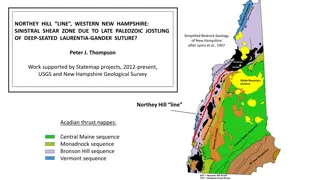Exploring Cyprus's Geological Wonders: Troodos Geopark
Discover the geological marvels of Cyprus through a historical review of Troodos Geopark, revealing how the island emerged from the depths of the ocean due to tectonic movements. Unveil the ancient ophiolite rocks of the Troodos mountain range, showcasing the collision of African and Eurasian plates. Delve into the unique stratigraphic units and witness the world-renowned completeness of this ophiolite formation.
Download Presentation

Please find below an Image/Link to download the presentation.
The content on the website is provided AS IS for your information and personal use only. It may not be sold, licensed, or shared on other websites without obtaining consent from the author. Download presentation by click this link. If you encounter any issues during the download, it is possible that the publisher has removed the file from their server.
E N D
Presentation Transcript
Troodos Geopark: A historical review of Cyprus GROUP 2 : DESISLAVA VASILEVA RADOSTINA MARKOVA MARIA KOZAKOY ADELINA PAPAPETROY
How Troodos came to the surface? Cyprus was formed as a result of a series of unique events which has made the island a geological show case. About 90 million years ago, Cyprus was part of the bottom of a deep ocean, called Tethys. Tectonic movements at that time resulted in the collision of the African with the Eurasian plate, ultimately giving birth to the island. The Troodos Massif itself first rose above the ocean around 20 million years ago along with its smaller sister in the north of the island, the Pentadactylos range.
Ophiolite The Troodos mountain range is an ophiolite, a term used to describe a group of igneous rocks which make up the oceanic crust. Troodos is part of a very ancient section of oceanic crust which was uplifted to its present position due to the collision of the African and Eurasian Tectonic Plates and the subduction of the former beneath the latter. It is considered the most complete and best-studied ophiolite in the world. On Troodos one finds all the groups of ophiolite rocks, consisting of the following stratigraphic units, in ascending order: (a) Mantle sequence and cumulates (b) Plutonic rocks (c) Intrusives (d) Volcanics and pillow lava flows (e) Chemical sediments such as umber























